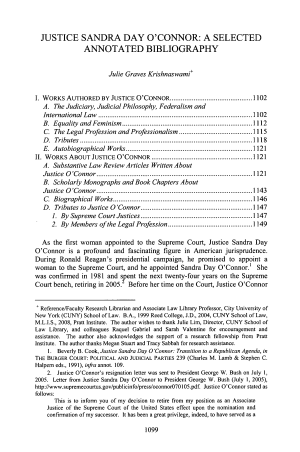Justice Sandra Day O'Connor: A Selected Annotated Bibliography
June 1, 2008

DISCLAIMER: This text has been transcribed automatically and may contain substantial inaccuracies due to the limitations of automatic transcription technology. This transcript is intended only to make the content of this document more easily discoverable and searchable. If you would like to quote the exact text of this document in any piece of work or research, please view the original using the link above and gather your quote directly from the source. The Sandra Day O'Connor Institute does not warrant, represent, or guarantee in any way that the text below is accurate.
Article Text
(Excerpt, Automatically generated)
JUSTICE SANDRA DAY O'CONNOR: A SELECTED ANNOTATED BIBLIOGRAPHY
Julie Graves Krishnaswam/
WORKS AUTHORED BY JUSTICE O'CONNOR 1102
The Judiciary, Judicial Philosophy, Federalism and
International Law 1102
Equality and Feminism 1112
The Legal Profession and Professionalism 11 l 5
Tributes 1118
Autobiographical Works 1121
WORKS ABOUT JUSTICE O'CONNOR 112 l
Substantive Law Review Articles Written About
Justice O'Connor 112 l
Scholarly Monographs and Book Chapters About
Justice O'Connor 1143
Biographical Works 1146
Tributes to Justice O 'Connor 1147
By Supreme Court Justices 1147
By Members of the Legal Profession 1149
As the first woman appointed to the Supreme Court, Justice Sandra Day O'Connor is a profound and fascinating figure in American jurisprudence. During Ronald Reagan's presidential campaign, he promised to appoint a woman to the Supreme Court, and he appointed Sandra Day O' Connor. 1 She was confirmed in 1981 and spent the next twenty-four years on the Supreme Court bench, retiring in 2005. Before her time on the Court, Justice O'Connor
- Reference/Faculty Research Librarian and Associate Law Library Professor, City University of New York (CUNY) School of Law. B.A., 1999 Reed College, J.D., 2004, CUNY School ofLaw, M.L.I.S., 2008, Pratt Institute. The author wishes to thank Julie Lim, Director, CUNY School of Law Library, and colleagues Raquel Gabriel and Sarah Valentine for encouragement and assistance. The author also acknowledges the support of a research
